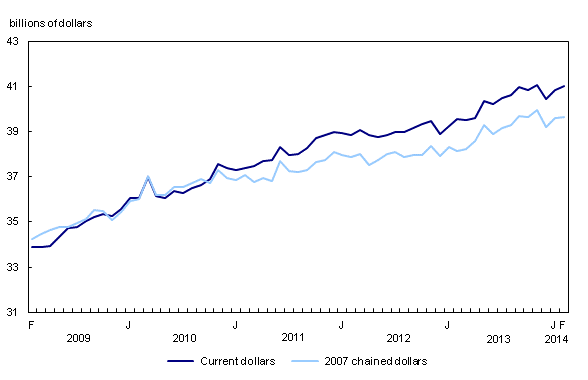Retail trade, February 2014
Archived Content
Information identified as archived is provided for reference, research or recordkeeping purposes. It is not subject to the Government of Canada Web Standards and has not been altered or updated since it was archived. Please "contact us" to request a format other than those available.
Released: 2014-04-23
Retail sales rose 0.5% to $41.0 billion in February. Gains were reported in 7 of 11 subsectors, representing 56% of total retail sales. Excluding sales at gasoline stations and motor vehicles and parts dealers, sales advanced 0.8%.
After removing the effects of price changes, retail sales in volume terms rose 0.1%.
Most subsectors post higher sales in February
Health and personal care stores (+2.6%) recorded the largest advance in dollar terms among all subsectors on the strength of higher sales at pharmacies and drug stores and, to a lesser extent, food supplement stores.
Retail sales at general merchandise stores grew 1.4%. Sales in the "other general merchandise stores" industry grew for a third consecutive month.
Following flat sales in January, food and beverage store sales grew 0.5% as a result of higher sales at all store types. A 0.4% increase at supermarkets and other grocery stores accounted for most of the gain, while sales at specialty food stores grew 1.6%. Convenience stores (+1.1%) and beer, wine and liquor stores (+0.1%) both advanced for the third consecutive month.
Following two straight monthly declines, clothing and clothing accessories stores reported a 1.5% increase in February. Higher sales were reported at clothing stores (+1.8%), shoe stores (+0.8%) and jewellery, luggage and leather goods stores (+0.1%).
After advancing 1.0% in January, sales at electronics and appliance stores rose 1.3% in February. Sales in this subsector have begun to stabilize after larger than normal fluctuations in November and December.
The largest decline in dollar terms was reported at building material and garden equipment and supplies dealers (-1.4%), the fifth monthly decrease in six months.
Sales at gasoline stations declined 0.3% in February, the first decrease in four months.
Sales at motor vehicle and parts dealers were unchanged from January. New car dealers edged down 0.1%. Sales were down at used car dealers (-0.4%) and other motor vehicle dealers (-1.8%). Sales in automotive parts, accessories and tire stores were up 2.6%.
Sales up in seven provinces
Retail sales rose in seven provinces in February. The increase was largely attributable to higher sales in Ontario and, to a lesser extent, Quebec and Alberta.
Ontario (+0.8%) reported the largest increase in dollar terms as gains were widespread across most store types.
In Quebec (+0.7%), sales advanced largely as a result of higher sales at new car dealers.
Sales in Alberta (+0.9%) advanced on the strength of higher sales at other general merchandise stores.
Sales advanced for the second consecutive month in each of the Atlantic provinces, led by Nova Scotia (+1.4%) and New Brunswick (+1.5%).
British Columbia (-1.0%) reported the largest decrease in dollar terms, mostly due to weaker sales at building, material and garden equipment and supplies dealers.
The 1.3% sales decline in Manitoba was partially attributable to weaker sales at new car dealers.
It is possible to consult tables of unadjusted data by industry and by province and territory in the Tables by subject module of our website.
For information on related indicators, refer to the Latest statistics page on our website.
Note to readers
All data in this release are seasonally adjusted and in current dollars, unless otherwise noted. For more information on seasonal adjustment, see "Seasonal adjustment and identifying economic trends."
Total retail sales expressed in volume are calculated by deflating current dollar values using consumer price indexes. The retail sales series in chained (2007) dollars is a chained Fisher volume index with 2007 as the reference year. For more information, see Calculation of Volume of Retail Trade Sales.
At the end of each calendar year, seasonally adjusted monthly figures are revised to equal the sum of the unadjusted estimates. With this release, unadjusted and seasonally adjusted monthly data were revised back to January 2004. Factors influencing revisions include late receipt of respondent information, correction of information in the data provided, the replacement of estimated figures with actual values (once available), the re-classification of companies within, into and out of the retail trade industry and updates to seasonal factors, including trading day weights. Data in volume terms have also been revised back to January 2004.
The February 2014 issue of Retail Trade (Catalogue number63-005-X) will soon be available.
Data on retail trade for March will be released on May 22.
Contact information
For more information, or to order data, contact us (toll-free 1-800-263-1136; 514-283-8300; infostats@statcan.gc.ca).
For analytical information, or to enquire about the concepts, methods or data quality of this release, contact Kimberley Evans (613-951-0502; kimberley.evans@statcan.gc.ca), Retail and Service Industries Division.
- Date modified:


